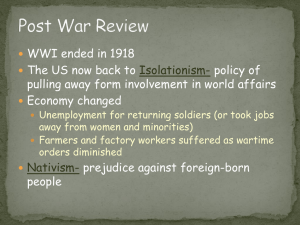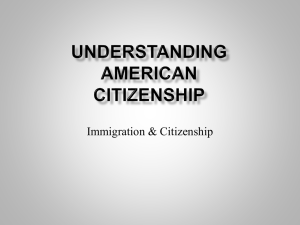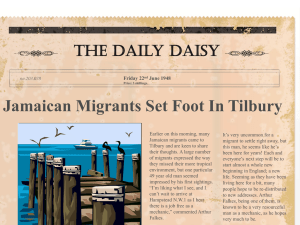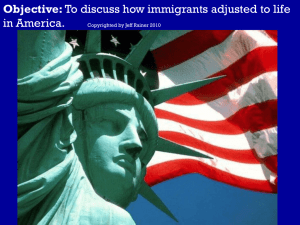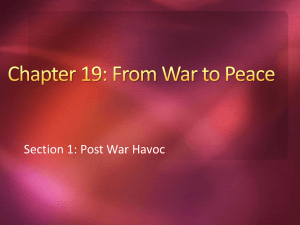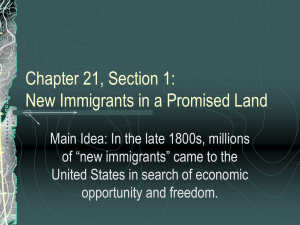Petkou-2014-CAPE-TOWN-PRESENTATION-1
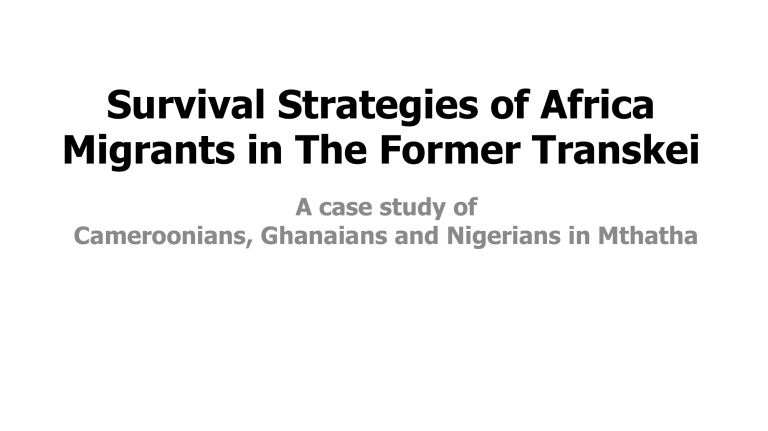
Survival Strategies of Africa
Migrants in The Former Transkei
A case study of
Cameroonians, Ghanaians and Nigerians in Mthatha
Outline
Background
Study Area and Methodology
Review
Discussions
Conclusions and Recommendations
Background
As Immigrants continue to enter South Africa, some earlier and recent immigrants already in the country begin to migrated into rural areas to secure their survival.
Since 2000, large influxes of immigrants from big cities to
Mthatha
Even though the province is among the least attractive destination for foreigners.
Since the early 90s, the informal economy has risen significantly
The majority of its entrepreneurs are foreigners.
Background(cont.)
Nkwa (2007) notes that immigrants come to Mthatha in search for employment, better wages and to escape from persecution and violence from their previous places of residence.
Yet African migrants in Mthatha face many challenges and hence a need to survive.
The focus of this paper is to investigate their survival strategies in Mthatha.
Categories of foreign Migrants
1. Earlier foreign migrants
Those who arrived in Mthatha between 1990 and the year 2005.
Already established in their socio-economic endeavours
Have legal Documentation and a rented place of their own to stay .
Earlier foreign migrants (cont.)
Run their own small scale businesses and/or working in an established organisation
Can speak the local language fluently
Have established complex social networks with the locals.
Categories of foreign Migrants (cont.)
2.
Recent foreign migrants
Entered Mthatha after the year 2005.
Do not have a place of their own to stay
Unemployed or self-employed and actively looking for employment
Struggling to regularise their documentation
Recent foreign migrants (cont.)
Can barely speak the local language
Loose social networks with the locals
Strong attachments with earlier foreign migrants
Immigrants’ Experiences in Mthatha
Not different from others elsewhere in South Africa
Foreign migrants face similar adversities
Experience deplorable treatment from state agencies, organisations, communities
Suffer from acute discrimination and xenophobic tendencies
Similar reports of discrimination, harassments and violence against foreigner nationals like elsewhere in South Africa
Some examples
Notable Examples of News Paper Reports
“foreign mum and baby gunned down’,
‘foreign shops looted’, ‘foreign national killed’, ‘…believes foreigners are
bad for South Africa’,
‘foreign man stabbed to death’
“xenophobic” violence that has been stalking Gauteng has spread to the
Eastern Cape and the Free State Patel (2013).
Attacks against foreign nationals in KwaZakhele & New Brighton in Port
Elizabeth, left several shops looted and burnt
Due to the level of xenophobic violence, police had to relocate some of the foreign nationals to temporary shelters (Human Rights Watch of 21
Jan 2014).
Hence a need for Foreign migrants to devise strategies for survival in
Mthatha.
Study Area
Mthatha in the Eastern Cape Province of South Africa.
Mthatha was the capital town of the former Transkei
The main town of the King Sabata Danlindyebo Local Municipality (KSD)
Population of about 120,000 with 55% younger than 20 years
The town is along the N2 road, 250 Km from East London and about 177
Km to Kokstad.
Reasons for the choice of Mthatha
1. The District Municipality is the poorest in the Eastern Cape
2. High percentage number of people living in poverty
3. About 11.8% of its households without any form of income
4. Unemployment rate a high of 65.5%,
Study Area (cont.)
5. Literacy rate of only 42% .
6. Experiencing high in flocks of African migrants.
7. Not much research has been conducted to find out the survival strategies of African immigrants in smaller towns around the country.
Study Area (cont.)
The study immigrants form a minority group which generally faces prejudice and discrimination in their communities.
The choice of Mthatha, a much smaller town in a typical rural region in the province will add to the limited empirical referents on immigrants’ survival strategies in noncosmopolitan cities
Study Methodology
Both qualitative and quantitative research methodologies
Techniques include: Questionnaires, Observations, Focus group discussions and in-depth interviews
But a more qualitative approach was adopted
150 opened-ended questionnaires were administered
Snowball sampling was used to facilitate the identification of respondents
Focus group discussion, in-depth interviews and observations were conducted (places of work, homes and their social gatherings).
Data analyzed using excel
Findings presented in tables, charts and diagrams
Literature Review
Abundance of literature on immigrants’ survival strategies in South
Africa (e.g. Petkou, 2005; 2010).
Not much has been done in rural areas of South Africa
Much of what has been done is focus on urban immigrants as crime perpetrators, immigrants as entrepreneurs and better than those from SADC countries, and/or immigrants as drug dealers and in prostitution.
Literature Review (cont.)
Previous and recent literature focus on urban immigrants with similar patterns of survival
In Johannesburg for example, studies show that because of discrimination and xenophobia, immigrants used various strategies to adapt themselves to the prevailing situation.
Strategies include: bogus documentation, adopting the social culture, forming social organisations, engaging into marriages of convenience, learning the local language, opening up small scale businesses and others engaging in activities beyond the margins of the law.
Literature Review (cont.)
Studies elsewhere have shown that, discriminated immigrants with the ambitions of improving their lifestyles, developed an economic consciousness, which act as a motivating factor for profit making (MacGaffey and Bazenguissa-Ganga 2000).
acquiring legal documentation is crucial for immigrants’ survival in
South Africa hence, many immigrants who entered the country
Literature Review (cont.) with visitors visa apply for Asylum Seeker permits which give them the right to stay and look for employment (Mluleki, (2003).
Others conspired with corrupt officials to secure legal documentation (Yawlui,
2009).
Studies have identified the formation of social organisations as survival strategy
(Muzondidya, 2008; Mluleki, 2003; McDonald et al, 2002; Ojong, 2007).
Learning the local languages (Yawlui, 2009; Mluleki, 2003; Nkwa, 2008; Ojong,
2007)
Adopting the South Africa dressing and hair styles (Nkwa, 2008).
Literature Review (cont.)
Little empirical referent exist which discusses the survival strategies of foreign migrants in rural South Africa.
This study form an addition to that gap
Yet to know if African immigrants in Mthatha pursue similar strategies like urban immigrants in South Africa
If not, then it creates new grounds for comparative study
Studies indicate the absence of original and up-to-date empirical data on migration patterns in the Eastern Cape
Province
Literature Review (cont.)
But, two broad patterns of migration can be observe in the province.
1. Movement of people from one part of the province to others
2. Movement of people from the Eastern Cape to other provinces (Makiwane and Chimere-Dan, 2010).
Golooba-Mutebi & Tollman (2004) observe similarly that, many refugees have consciously refrained from going to live or work in urban areas where living costs are high.
They have opted to live in rural areas because of the opportunities for livelihood diversification and the wider scope for securing support when in difficulties.
Literature Review (cont.)
Studies have also shown that the pattern of internal migration in the province is a pressing development challenge: “large volumes of people move to other parts of the country and other parts of the province in ways that on balance do not encourage broad-based development of the province” (Makiwane and
Chimere-Dan, 2010: 101) .
International migration into the province has not been a major policy challenge
White emigration and brain drain have been observed as some of the potential undesirable outcomes since 1994: But there is a possible reverse migration
Amongst these reverse migrants are foreign migrants who would take advantage of the prevailing gaps caused by out migration and brain drain in the province.
Literature Review (cont.)
Wundow (2011) study in Mthatha reported similar findings with studies conducted in urban South Africa.
Namely, acquiring legal documentation, organising marriages of convenience, learning the local languages and adopting the social culture
For Golooba-Mutebi & Tollman (2004) , Mozambican refugees in rural South
Africa have managed to move on from initial short-term survival strategies to achieve long-term livelihoods.
1. For one reason or another depend on their own ingenuity
2. Take advantage of freedom of movement in the country to search for places of permanent settlement.
3. Relatively stabled previous immigrants paved the way for new comers and played an important role in looking for paid employment at their own places of work.
Literature Review (cont.)
4. Survival was ensured by the combined efforts of the Gazankulu government, churches, charitable organizations, local villagers and, in some cases, the refugees’ own efforts.
5. But time, and as resources dwindled, immigrants start to practice subsistence agriculture and animal husbandry
6. Others work in the commercial farming sector either as seasonal or permanent labourers
7. Others in formal and informal non-agricultural activities
8. mining and construction, petty trading, commuter taxi owners, domestic services and traditional medicine.
9. Others acquired citizenship through marriages with South Africans
10. Others Bribe civil servants or paying South Africans to claim them as relatives.
Findings and Discussion of Results
Ages of respondents: 15 and 54 years old
But, the majority between 30 and 39 years old (63%)
Males (65%) Females (35%)
Christians (80%) Muslims (16%) Atheists (4%)
72% speak English and only 2% could not speak the English language.
Up to 92% can speak some amount of IsiXhosa and IsiZulu
All the study immigrants have had formal education (Table 1 below)
Table 1: Educational Status of Foreign Migrants
Level of Education N
Secondary school Certificate. 11
Diploma
Higher national diploma
24
19
%
7%
26%
13%
Bachelor’s degree 94 53%
Postgrad (Masters) Degree 02
Total 150
1%
100
Findings and Discussion of Results (cont.)
Others have upgraded their educational status
30% have obtained higher diplomas
20% honours degrees
5% masters degrees: (“the only way to get a job is to get their certificate”).
45% were teachers
Rest were employed or self-employed as (Street vendors, Tailors, beauty salons, Electricians, motor-Mechanics, Computer technicians, restaurant owners, bar services).
Findings and Discussion of Results (cont.)
4% of the study immigrants claimed that they are unemployed.
60% were single and 40% were married with children.
56% were married to South Africa and 44% married to same nationality with their wives.
Earlier Foreign migrants in the study constitute 45%
Recent foreign migrants were 55% of the total.
Findings and Discussion of Results (cont.)
Majority came from Major cities as shown in Table 2 below.
Table 2: Previous Residence in South Africa
Previous Residence N %
Johannesburg
Cape Town
Durban
Pretoria
Pietermaritzburg
Port Elizabeth
East Landon
Form Home Country
7
3
22
43
32
28
10
5
5
2
14
29
21
19
7
3
Total 150 100
Livelihood Strategies of Foreign Migrants
Obtaining Legal Documentation
Engaging in Small family gardens
Small business endeavours (internet café, small shops, restaurants, beauty salons, etc.)
Learning the local languages
Adapting to the social lifestyle (dressing and hair styles, walking etc.)
Livelihood Strategies of Foreign Migrants
(cont.)
Organising Social get together (organisations)
Social Interactions with South Africans
Creating a Strong Social Network
Growing a large family
Organising Part-time work (teaching
)
Conclusions
Survival strategies of foreign migrants in Mthatha are to some extend similar to those of urban migrants elsewhere in the country.
Studies elsewhere have identified the strong educational background of African Immigrants in the country
Small business endeavours, adapting to the lifestyle, creating social organisations and strong social networks are similar survival practices of urban migrants elsewhere.
Conclusions (cont.)
Other practices observed in this study appears to be more livelihood strategies than just survival strategies.
These include:
1. Obtaining legal documentation
2. Engaging in small family farms/gardens
3. Learning the local language
4. Increasing the family size
Recommendations
Equal accessibility to education especially to children of foreign migrants in the country
Educate the community and officials dealing with foreign immigrants to respect and uphold the the constitutional provision which carters for the rights of all who live in South Africa including that of immigrants
Open up more opportunities and facilities for foreign migrants to boost up the local economy
Support business endeavours of foreign migrants to curb down high unemployment in the region
Encourage the revisiting of immigration policies in the country
Recommendations (cont.)
Create structures that monitor and sanction defaulters of human rights especially with foreign migrants
Encourage foreign migrants to live and consider South Africa as a home. In this way, local development will improve
Continue the fight against discrimination and xenophobia in the country.
Accommodate and assimilate immigrants especially in areas of employment and education.
See the presence of foreign migrants as an opportunity rather than a problem.
Dr. CL Petkou
Department of Sociology and Population
Development Studies, WSU Mthatha
Thank You

